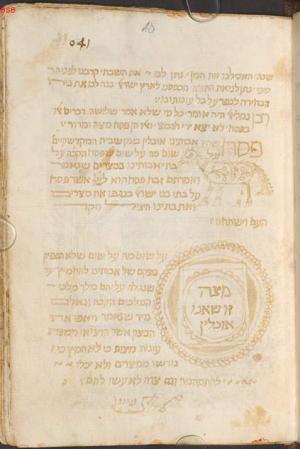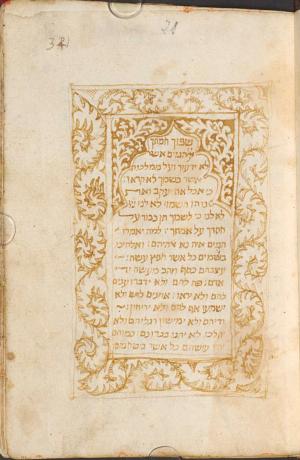Obj. ID: 18559
Hebrew Illuminated Manuscripts Prayer Book, Haggadah, and Sod Yesharim by Leon Modena, Fès-Boulemane (Morocco), Second half of the 19th century

The style and use of motifs in our Haggadah differ considerably from those of another Moroccan Haggadah and Dhir from Tafilalt, except for the similar shape of the maror (cf. figs. 1-3).
|
Fig. 1: Maror (bitter herb) Moroccan Prayer Book and Haggadah North-east Morocco, Fez-Boulmane region Second-half of 19th century Munich, BSB Cod.hebr. 455, fol. 18v |
|
Fig. 2: Maror (bitter herb) Passover Haggadah and Dhir Morocco, Tafilalt region 1838-1850 and c.1870 Munich, BSB Cod.hebr. 453, fol. 20 (Jerusalem, CJA Documentation) |
Fig. 3: Maror (bitter herb) Passover Haggadah and Dhir Morocco, Tafilalt, c.1875 Tel-Aviv Gross MO.011.011, fol. 11 © Tel-Aviv, Gross Family Collection |
On the other hand, the fine acanthus scrolls drawn by Scribe A (fig. 4) are similar to those found in a Dhir manuscript of the Gross collection, perhaps fromFez, c.1900 (fig. 5). In fact, even the full-page frame of the colophon of that manuscript enclosing a multifoil arch (fig. 6), recalls that in our manuscript, executed by Scribe B (fig. 7), rather than the twin arches of another Dhir from Tafilalt of 1897 (fig. 8). Despite the combination of fine and fleshy acanthus scrolls in our manuscript (fig. 9), it seems that its style is closer to manuscripts from the Fez-Boulmane region, either from Fez itself (figs. 5, 6) or Outat of 1870 (fig. 10), rather than those from Tafilalt.
|
|
|
|
Fig. 4: Moroccan Prayer Book and Haggadah North-east Morocco, Fez-Boulmane region Second-half of 19th century Munich, BSB Cod.hebr. 455, fol. 11
|
Figs. 5, 6: Morrocan Passover Haggadah and Dhir Morocco, Fez (?), c.1900 Tel-Aviv Gross, MO.011.019, fols. 3v-4 © Tel-Aviv, Gross Family Collection |
|
|
|
|
Fig. 7: Moroccan Prayer Book and Haggadah North-east Morocco, Fez-Boulmane region Second-half of 19th century Munich, BSB Cod.hebr. 455, fol. 21
|
Fig. 8: Morrocan Passover Haggadah and Dhir Morocco, Tafilalet, 1897 Tel-Aviv Gross, MO.011.076, fol. 16 © Tel-Aviv, Gross Family Collection |
|
|
|
|
Fig. 9: Moroccan Prayer Book and Haggadah North-east Morocco, Fez-Boulmane region Second-half of 19th century Munich, BSB Cod.hebr. 455, fol. 13v
|
Fig. 10: Morrocan Passover Haggadah and Dhir Outat, Fez-Boulmane region Morocco, 1870 Tel-Aviv Gross, MO.011.009, fol. 40v © Tel-Aviv, Gross Family Collection |
sub-set tree:
Two sets of foliation: one modern, fols. 1-31; in the second, fols. 1-651, the first digit denotes a folio number, while the second digit changes every 10 leaves). The following synchronises the two versions: fols. 1=321 (131); 2=421; 3=521; 4=621; 5=721; 6=821; 7=921; 8=031; 9=131; 10=231; 11=331; 12=431; 13=531; 14=631; 15=731; 16=831; 17=931; 18=041; 19=141; 20=241; 21=341; 22=441; 23=541; 24=641; 25=741; 26=841; 27=941; 28=251 (sic); 29=351;30=651 (sic).
Text space: (97-105) x (66-72) mm.
19th-century cardboard covered with dark brown leather, decorated with blind-tooled rectangular frames.
Restored with additions of brown leather in February 1971.
The decoration was done by the two scribes, each in his section, in the same shade of brown ink as their texts. Crude drawings were added on the blank pages (fols. 19, 24-27v, 30v-31) and on the back pastedown.
Scribe A:
Drawings: a vase and a box-shape flanking the text קדוש ונורא (Holy and Awesome; fol. 11); triangular shapes framed by a scroll marking the end of the prayers for New Year (fol. 12v).
Scribe B:
I.Text illustrations: a Torah ark, in the form of a gabled square with open doors decorated with foliage scrolls, encloses the words על אחת כמה וכמה (How numerous then and how oft repeated), which open the second half of the piyyut דיינו (Dayyeinu; fol. 17v); three illustrations for the mishna of Raban Gamliel: פסח מצה ומרור (Passover lamb, unleavened bread, and bitter herbs (fol. 18-18v): a lamb (fol. 18; crudely repeated, fol. 19); a round mazzah on a square napkin in a round dish (fol. 18); a maror as a stylised tree with three pairs of branches standing on a semi-circular base (fol. 18v; crudely repeated, fol. 19); the repeated text of the maror is marked by a three tiered V-shaped vessel (?) on a triangular foot, decorated with foliate scrolls (fol. 19v).
II. Decorated frames of spared-ground foliage scrolls: one full-page frame enclosing the beginning of the second part of the Haggadah, Pour out (שפוך, Shefokh; fol. 21); an initial word panel opening the first section of the Haggadah, This is the bread of affliction (הא לחמא, Ha Lahma; fol. 13v); a triangle which underlines the initial word of the Kiddush, Blessed (ברוך, Baruch; fol. 20), to be recited before the Seder meal.
III. Crude drawings on blank folios: a vase with six flowers, a decorated column and a lion (fol. 19); a six-pointed Star of David (fol. 24); horses (fols. 24v-25), one with a knight; a foliage scroll and an eight-pointed star by Scribe B (fols. 25v-26), partly coloured and imitated by a crude hand (fols. 25v-27v and back pastedown).
Note: A green folio number denotes it is described under "Illuminated Documents".













